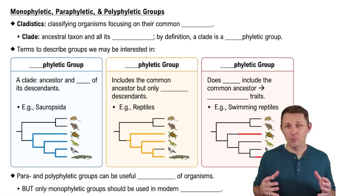Table of contents
- 1. Introduction to Biology2h 42m
- 2. Chemistry3h 40m
- 3. Water1h 26m
- 4. Biomolecules2h 23m
- 5. Cell Components2h 26m
- 6. The Membrane2h 31m
- 7. Energy and Metabolism2h 0m
- 8. Respiration2h 40m
- 9. Photosynthesis2h 49m
- 10. Cell Signaling59m
- 11. Cell Division2h 47m
- 12. Meiosis2h 0m
- 13. Mendelian Genetics4h 44m
- Introduction to Mendel's Experiments7m
- Genotype vs. Phenotype17m
- Punnett Squares13m
- Mendel's Experiments26m
- Mendel's Laws18m
- Monohybrid Crosses19m
- Test Crosses14m
- Dihybrid Crosses20m
- Punnett Square Probability26m
- Incomplete Dominance vs. Codominance20m
- Epistasis7m
- Non-Mendelian Genetics12m
- Pedigrees6m
- Autosomal Inheritance21m
- Sex-Linked Inheritance43m
- X-Inactivation9m
- 14. DNA Synthesis2h 27m
- 15. Gene Expression3h 20m
- 16. Regulation of Expression3h 31m
- Introduction to Regulation of Gene Expression13m
- Prokaryotic Gene Regulation via Operons27m
- The Lac Operon21m
- Glucose's Impact on Lac Operon25m
- The Trp Operon20m
- Review of the Lac Operon & Trp Operon11m
- Introduction to Eukaryotic Gene Regulation9m
- Eukaryotic Chromatin Modifications16m
- Eukaryotic Transcriptional Control22m
- Eukaryotic Post-Transcriptional Regulation28m
- Eukaryotic Post-Translational Regulation13m
- 17. Viruses37m
- 18. Biotechnology2h 58m
- 19. Genomics17m
- 20. Development1h 5m
- 21. Evolution3h 1m
- 22. Evolution of Populations3h 52m
- 23. Speciation1h 37m
- 24. History of Life on Earth2h 6m
- 25. Phylogeny2h 31m
- 26. Prokaryotes4h 59m
- 27. Protists1h 12m
- 28. Plants1h 22m
- 29. Fungi36m
- 30. Overview of Animals34m
- 31. Invertebrates1h 2m
- 32. Vertebrates50m
- 33. Plant Anatomy1h 3m
- 34. Vascular Plant Transport1h 2m
- 35. Soil37m
- 36. Plant Reproduction47m
- 37. Plant Sensation and Response1h 9m
- 38. Animal Form and Function1h 19m
- 39. Digestive System1h 10m
- 40. Circulatory System1h 57m
- 41. Immune System1h 12m
- 42. Osmoregulation and Excretion50m
- 43. Endocrine System1h 4m
- 44. Animal Reproduction1h 2m
- 45. Nervous System1h 55m
- 46. Sensory Systems46m
- 47. Muscle Systems23m
- 48. Ecology3h 11m
- Introduction to Ecology20m
- Biogeography14m
- Earth's Climate Patterns50m
- Introduction to Terrestrial Biomes10m
- Terrestrial Biomes: Near Equator13m
- Terrestrial Biomes: Temperate Regions10m
- Terrestrial Biomes: Northern Regions15m
- Introduction to Aquatic Biomes27m
- Freshwater Aquatic Biomes14m
- Marine Aquatic Biomes13m
- 49. Animal Behavior28m
- 50. Population Ecology3h 41m
- Introduction to Population Ecology28m
- Population Sampling Methods23m
- Life History12m
- Population Demography17m
- Factors Limiting Population Growth14m
- Introduction to Population Growth Models22m
- Linear Population Growth6m
- Exponential Population Growth29m
- Logistic Population Growth32m
- r/K Selection10m
- The Human Population22m
- 51. Community Ecology2h 46m
- Introduction to Community Ecology2m
- Introduction to Community Interactions9m
- Community Interactions: Competition (-/-)38m
- Community Interactions: Exploitation (+/-)23m
- Community Interactions: Mutualism (+/+) & Commensalism (+/0)9m
- Community Structure35m
- Community Dynamics26m
- Geographic Impact on Communities21m
- 52. Ecosystems2h 36m
- 53. Conservation Biology24m
27. Protists
Introduction to Protists
Problem 1`
Textbook Question
Why are protists considered paraphyletic?
a. They include many extinct forms, including lineages that no longer have any living representatives.
b. They include some but not all descendants of their most recent common ancestor.
c. They represent all of the descendants of a single common ancestor.
d. Not all protists have all of the synapomorphies that define the Eukarya, such as a nucleus.
 Verified step by step guidance
Verified step by step guidance1
Understand the definition of a paraphyletic group: A paraphyletic group consists of an ancestral species and some, but not all, of its descendants.
Identify the characteristics of protists: Protists are a diverse group of eukaryotic organisms that do not fit into the other kingdoms such as plants, animals, or fungi.
Analyze the options given: Consider which option describes a group that includes some but not all descendants of a common ancestor.
Option b states that protists include some but not all descendants of their most recent common ancestor, which aligns with the definition of a paraphyletic group.
Conclude that protists are considered paraphyletic because they do not include all descendants of their most recent common ancestor, as described in option b.
 Verified video answer for a similar problem:
Verified video answer for a similar problem:This video solution was recommended by our tutors as helpful for the problem above
Video duration:
2mPlay a video:
Was this helpful?
Key Concepts
Here are the essential concepts you must grasp in order to answer the question correctly.
Paraphyletic Group
A paraphyletic group consists of organisms that include some, but not all, descendants of a common ancestor. This means that while they share a common lineage, the group excludes certain descendants that have diverged from the main lineage, making it incomplete in terms of evolutionary relationships.
Recommended video:

Monophyletic, Paraphyletic, & Polyphyletic Group
Protists
Protists are a diverse group of eukaryotic microorganisms, which are not classified as plants, animals, or fungi. They exhibit a wide range of characteristics and can be unicellular or multicellular. Due to their diversity and evolutionary history, protists do not form a monophyletic group, leading to their classification as paraphyletic.
Recommended video:
Guided course

What is a Protist?
Synapomorphies
Synapomorphies are shared derived traits that are used to determine evolutionary relationships among organisms. In the context of Eukarya, synapomorphies include features like a nucleus and membrane-bound organelles. Not all protists possess these defining traits, which contributes to their classification as paraphyletic within the broader eukaryotic lineage.
Recommended video:
Guided course

Cladistics
Related Videos
Related Practice
























